Water Problem Areas For Wood Stairs
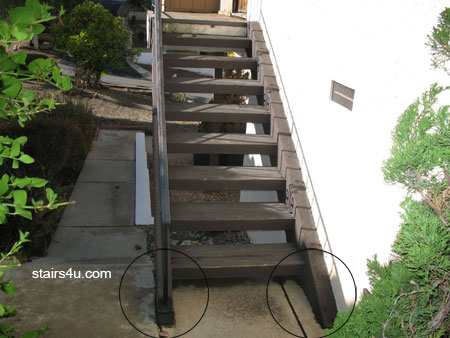
We should probably start with the biggest water problem area for wood
stairs and that will be at the bottom or base of the stairway. Exterior wood
stairways can get wet, if they aren't covered by a roof or other type of
covering and this usually creates the possibility of a variety of different
types of damage.
In the picture above you can see where moisture or
water has accumulated on the concrete walkway under each side of the
stringers and overtime it will start to rot the wood. If the damage
continues, the stairway will need to be replaced and if and when that time
comes, it wouldn't be a bad idea to raise the stairway off the ground with
some type of building hardware.
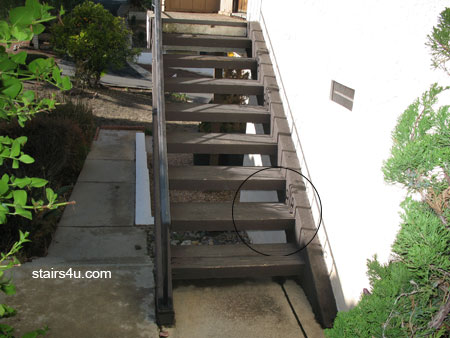
Here's another problem area, where the stair treads meets the stringers.
These areas usually collect debris and dirt and if these areas aren't
cleaned regularly could lead to wood rot.
The fact that the stairway
is in the shade isn't doing it much good either. As debris or dirt
accumulates in any gap or other parts of the stairway and it doesn't get a
chance to dry out, because the sun isn't shining on it or is only shining on
it a few hours a day, then these areas will remain moist and start to
decompose or rot.
It's kind of a catch 22, too much sun can damage a
stairway, just like too much shade.
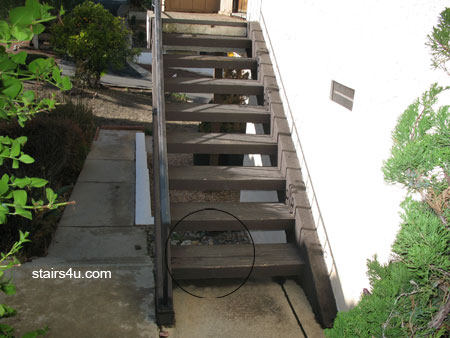
It's probably hard to see, but the first tread or step has a large crack
in it and these cracks can retain large amounts of moisture, for long
periods of time. As long as there's moisture in the cracks, the wood will
suck it up like a sponge and transfer it to other parts of the stairway,
including the metal handrail
The solution to this problem is simple
in most cases, simply fill the gaps or cracks with a durable exterior
caulking and paint or seal the stairway.
The key to maintaining your
property is to actually inspect it every once in a while and then, I know
this is going to sound hard to believe, but you will need to actually make
the necessary repairs. You really can extend the life of a wood stairway by
taking a little time to inspect and repair wood damage on a regular basis.
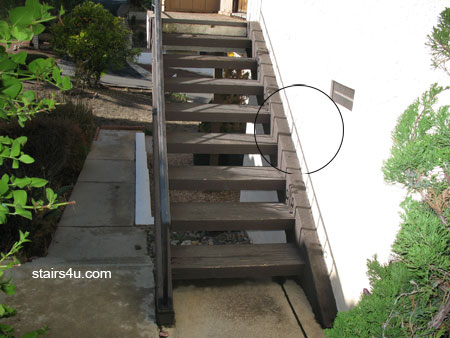
Here's another problem area and it will all depend upon how the stairway
was built or attached to the exterior stucco wall. If metal flashing has
been installed or the stairway is separated from the stucco by at least a
half-inch, then something like this might not be a big concern.
However, if the wood stair stringer is actually touching the stucco, then
there's a good chance the stringer will become damaged, because cement
products like stucco and concrete can absorb and retain moisture for long
periods of time, allowing some of it to also get absorbed into the wood.
After a while the moisture will either attract termites or start the
natural decomposition process of rotting the wood.
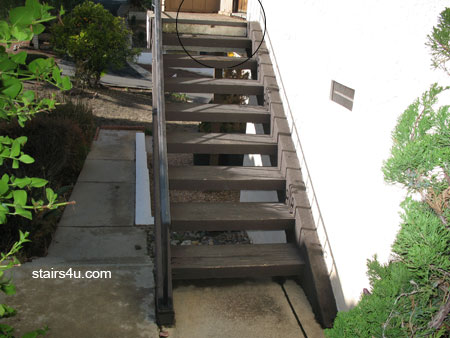
Finally we get to the top of the stairway and this could present us with
another problem, depending upon how the landing was finished and
constructed. If metal flashing had been installed properly and the upper
landing slopes away from the stairway, then it might not be a problem.
However, almost every stair design I run into like this has the landing
sloping towards the wood stairs and every time it rains, the wood stairs get
soaked. Even if it doesn't rain, but there's enough moisture in the air on a
regular basis, the sloped landings can continue to feed water to other wood
stair parts, with the possibility of suffering damage in the future.
These are all problem areas architects and building designers should be
concerned with, as well as property owners who need to do a better job
maintaining their wood stairways.


